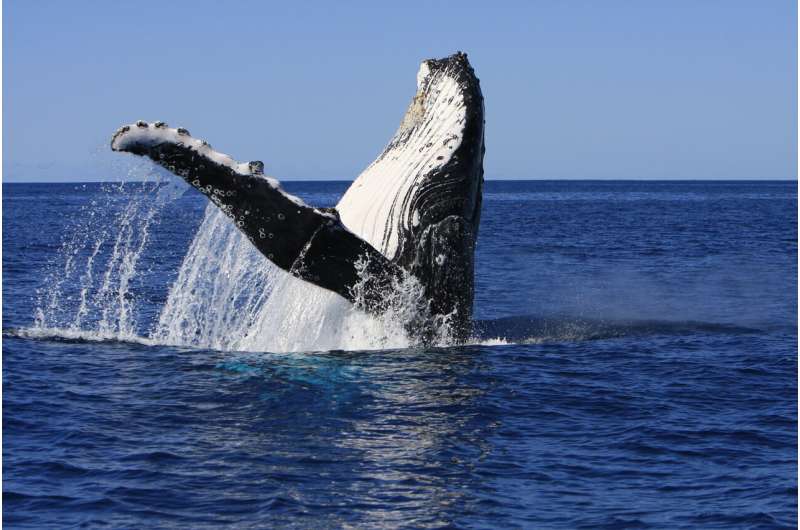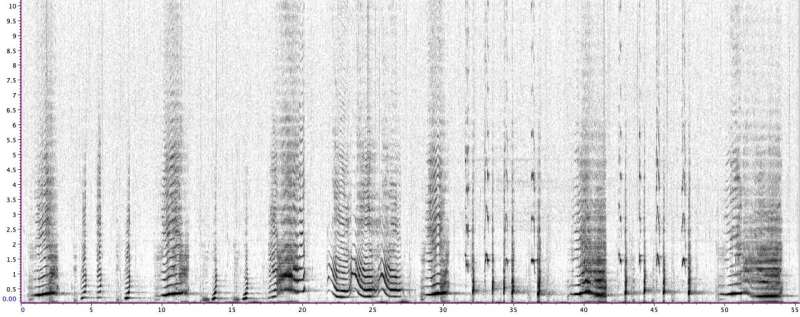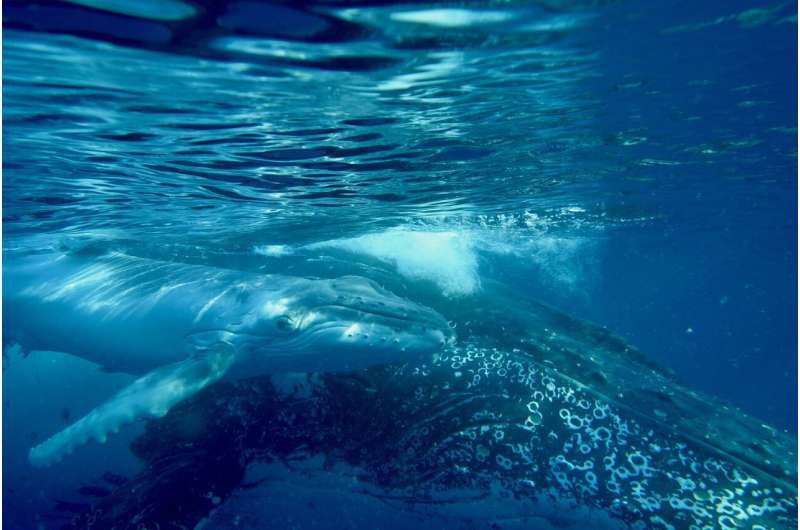This article has been reviewed according to Science X's editorial process and policies. Editors have highlighted the following attributes while ensuring the content's credibility:
fact-checked
peer-reviewed publication
trusted source
proofread
Humpback whale song shown to be structurally similar to human language

Language has long been considered a uniquely human trait, with features that mark it out as distinct from the communication of all other species. However, research published in Science has uncovered the same statistical structure that is a hallmark of human language in humpback whale song.
Humpback whale song is a striking example of a complex, culturally transmitted behavior, but up to now, there was little evidence it has a language-like structure. Human language, which is also culturally transmitted, has recurring parts whose frequency of use follows a particular pattern.
In humans, these properties help learning and may come about because they help language be passed from one generation to the next. This work innovatively applies methods inspired by how babies discover words in speech to humpback whale recordings, uncovering the same statistical structures found in all human languages.
This work reveals previously undetected structure in whale song, illustrating a deep commonality between two unrelated species united by the fact that their communication systems are culturally transmitted.
Led by Professor Inbal Arnon of the Hebrew University, Dr. Ellen Garland of the University of St Andrews, and Professor Simon Kirby of the University of Edinburgh, in collaboration with Dr. Claire Garrigue (IRD New Caledonia), Dr. Jenny Allen (Griffith University), and Dr. Emma Carroll (University of Auckland), this work represents a unique collaboration between linguists, developmental scientists, marine biologists and behavioral ecologists.
Humpback whale song is one of the most striking examples of a socially learned, culturally transmitted behavior in a nonhuman animal. Whale song exhibits systematic structure. However, until now, there was little evidence that this structure was like that of human language. One of the big challenges in studying non-human communication is finding out what the relevant parts of the system are.
The authors' breakthrough was to use insights from how babies discover words in speech, and apply them to eight years of humpback whale song data collected in New Caledonia.
The authors found that whale song showed the same key statistical properties present in all known human languages. They detected recurring parts whose frequency closely followed a particular skewed distribution, not previously found in any other non-human animal.
This work reveals a deeply unexpected commonality between two unrelated species—humans and humpback whales—united by the fact that their communication system is culturally transmitted.
This points to the crucial role of learning and transmission in the emergence of structure within such systems. Once thought of as the hallmark of human uniqueness, foundational aspects of human language may be shared across evolutionary-distant species.

Dr. Ellen Garland from the University of St Andrews said, "Revealing this hidden language-like structure in whale song was unexpected, but it strongly suggests this cultural behavior holds crucial insight into the evolution of complex communication across the animal kingdom."
"Whale song is not a language; it lacks semantic meaning. It may be more reminiscent of human music, which also has this statistical structure, but lacks the expressive meaning found in language."
"Whether the units we detected using the infant-inspired method are salient to the whales themselves remains an open question."
Prof Inbal Arnon from the Hebrew University said, "Using insights and methods from how babies learn language allowed us to discover previously undetected structure in whale song"
"This work shows how learning and cultural transmission can shape the structure of communication systems: we may find similar statistical structure wherever complex sequential behavior is transmitted culturally."
"It raises the intriguing possibility that humpback whales, like human babies, may learn their song by tracking transitional probabilities between sound elements, and using dips in those probabilities as a cue to segment the song"

Prof Simon Kirby from the University of Edinburgh said, "It suggests that our understanding of the evolution of language can benefit not only from looking at our closest primate relatives, but also at cases of convergent evolution elsewhere in nature."
"Looking beyond the way language is used to express meaning, we should consider how language is learned and transmitted culturally over multiple generations."
"These findings challenge long held assumptions about the uniqueness of human language, uncovering deep commonalities between evolutionarily distant species."
More information: Inbal Arnon et al, Whale song shows language-like statistical structure, Science (2025). DOI: 10.1126/science.adq7055. www.science.org/doi/10.1126/science.adq7055
Journal information: Science
Provided by Hebrew University of Jerusalem

















